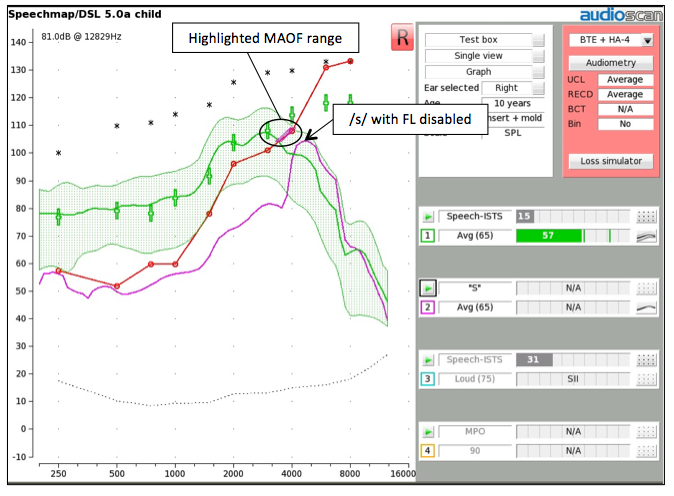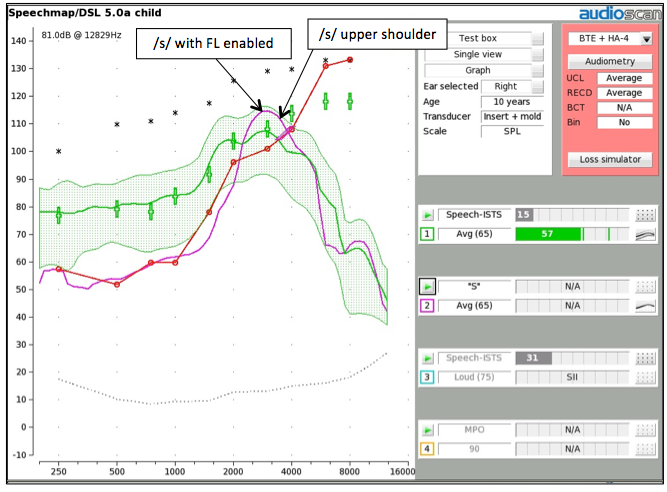Question
Can I use my hearing instrument fitting system to verify current frequency lowering (FL) hearing aid technology?
Answer
Answer: Yes, both real-ear measurements (REM) and simulated real-ear measurements (S-REM) conducted via the test box, used in combination with appropriate test signals, can offer assistance when determining FL candidacy for current technologies and when interpreting the effects of FL adjustments.
FL is commonly used as an umbrella term to describe the many different types of digital signal processing (DSP) technologies that can be used to move, in frequency, an incoming signal to a lower output frequency. Even with “extended bandwidth” hearing aids, we still see hearing aid gain/bandwidth limitations affecting audibility of high-frequency signals for some listeners. This is especially true for listeners with severe-profound hearing loss and for audibility of high-frequency speech sounds such as /s/.
Before we discuss which verification measures might be useful for you, let’s consider some commonalities across current FL technologies:
- All FL technologies aim to provide access to a wider range or bandwidth of spectral content for aided listeners.
- Manufacturer-specific fitting software can be used to disable, enable, and adjust the strength of FL.
- Each manufacturer’s FL scheme is a little bit different. Objective verification measures can let you see the exact effects of FL for your patient.
Using REM or S-REM, we can capture the aided response of a given fitting, while incorporating the individual listener’s ear canal acoustics. For FL fittings, this means that we can capture the unique lowering effect a processor has on the aided response and what this means for the listener in terms of audibility. This can be evaluated with and without FL enabled, to help determine candidacy for FL, and across different settings to help optimize the FL setting. This verification approach also relies on the fitter using a calibrated signal during REM or S-REM that is sensitive to the effects of FL.
Here are some steps you can use to make the most of your verification measurements (REM or S-REM) with FL technology:
1. Verify the shape and gain of the aided response with FL disabled.
This allows you to establish a “baseline” fitting to compare back to. In this step, we disable FL and adjust the gain in the hearing aid to match the fitting formula targets across frequencies. This step provides the greatest possible bandwidth of audibility. A measurement of the aided spectrum for a standard speech signal measured at 65 dB SPL (i.e., ‘average’ speech) will come in handy during this process. Specifically, a display of the aided long-term average speech spectrum (LTASS), with visual peaks and valley measurements are useful.
2. Determine whether the listener is a candidate for FL (still with FL disabled).
This step involves assessing whether there is a possibility of improving the audibility of high-frequency sounds with FL (Figure 1). Here are some points to consider when assessing FL candidacy:
- Display the aided fit to targets from Step 1.
- Measure the aided response of a calibrated /s/ signal, with FL disabled and noise reduction features turned off. Our calibrated /s/ has been developed and validated for use in the verification of both static and adaptive types of FL technology (Scollie et al., 2016). It is important to note that not all signals work optimally with newer types of FL technologies that use adaptive DSP. Signals such as the calibrated /s/, available within the Audioscan Verifit and Verifit2, can help increase the validity of measurements completed with newer FL technologies, when compared to other types of commonly used test signals.
- Assess whether the /s/, including the upper shoulder, falls within the maximum audible output frequency (MAOF) range for a speech signal at a known level, such as 65 dB SPL. In other words, the fitter can gain useful information by evaluating the bandwidth of speech made audible without FL and whether this includes audibility specific to high-frequency phonemes, such as /s/.
- The MAOF range is defined by the point at which the LTASS crosses the hearing threshold line to the point at which the peaks of speech cross threshold. Visually, this MAOF range can be depicted on the Verifit2 using the ‘MAOF highlighter’, which can be enabled during a measurement of /s/ after first recording an average speech (65 dB SPL) input signal (e.g., Test 1). The MAOF highlighter colors the target MAOF range for the fitter on the SpeechMap® screen, allowing for faster and easier interpretation.

Figure 1. Simulated real-ear (test box) measurement of the aided LTASS for speech-ISTS at 65 dB SPL (Test 1 – green), an aided measurement of the /s/ signal (Test 2 – pink) and the corresponding highlighted MAOF range, measured with FL disabled. The /s/ signal is not audible for this listener without FL, and does not fall within the highlighted MAOF range.
3. Enable and fine-tune FL.
In this final step, we evaluate the aided response for /s/ with FL enabled. The goals are to ensure audibility of the /s/, using the weakest possible FL setting. Visually, the fitter is looking for the upper shoulder of the /s/ signal to fall within the highlighted MAOF range, and as close to peak-threshold intersection as possible (Figure 2). Fine-tuning of the FL settings may be required to achieve this goal. This procedure allows the fitter to manipulate the strength of the FL using manufacturer-specific software, while measuring the direct result on high-frequency audibility via REM or S-REM, allowing for clearer interpretation of the effect of various FL settings. Here are notes and additional suggestions when fine-tuning FL:
- Using the weakest possible FL setting that places the /s/ in the highlighted MAOF range will help ensure that you have maintained the highest level of sound quality for a given FL fitting, when compared to stronger FL settings (refer to Parsa, Scollie, Glista, & Seelisch, 2013 and Souza, Arehart, Kates, Croghan, & Gehani, 2013). This approach also minimizes the potential for confusion errors between various high-frequency phonemes, particularly /s/ and /ʃ/.
- You can leave the /s/ signal running when exploring different settings for faster results.
- For some listeners with severe-profound hearing loss in the high-frequencies, it may not be possible to achieve full audibility of the /s/.
- Alternatively, for listeners with better residual hearing in the high-frequencies, FL may not be needed to ensure full audibility of the /s/ signal. For example, if verification measures indicate full audibility of the calibrated /s/ with FL disabled, candidacy for FL may not be suggested for the listener and hearing aid processor in question.
- Don’t forget to re-enable noise-reduction features once you have completed the fitting, if applicable.

Figure 2. The same speech spectrum has been displayed in Test 1 and /s/ has been re-measured in Test 2 with a fine-tuned FL setting to place the upper shoulder within the highlighted MAOF range, using the weakest possible setting. An adaptive form of FL was used in this example.
4. Provide post-fitting support.
This may include counselling around the use and sound quality of FL, in addition to performing supplemental outcome measurements to validate performance with FL hearing aid technology. Basic listening checks can be useful in this step. Listening checks can be completed via monitoring headphones used in combination with real-ear or test box measurements, for example.
This article is meant to provide a basic summary of simple steps to follow when verifying and adjusting current types of FL technology. In some cases, additional steps may be needed to help troubleshoot or counsel difficult fittings. Further FL verification guidance can be found in Glista, Hawkins, & Scollie, 2016 and Scollie et al., 2016.
References
Glista, D., Hawkins, M., & Scollie, S. (2016, May). An update on modified verification approaches for frequency lowering devices. AudiologyOnline, Article 16932. Retrieved from www.audiologyonline.com
Parsa, V., Scollie, S., Glista, D., & Seelisch, A. (2013). Nonlinear frequency compression: Effects on sound quality ratings of speech and music. Trends in Amplification, 17(1), 54-68.
Scollie, S., Glista, D., Seto, J., Dunn, A., Schuett, B., Hawkins, M., . . . Parsa, V. (2016). Fitting frequency-lowering signal processing applying the AAA Pediatric Amplification Guideline: Updates and protocols. Journal of the American Academy of Audiology, 27(3), 219-236.
Souza, P.E., Arehart, K.H., Kates, J.M., Croghan, N.B.H., & Gehani, N. (2013). Exploring the limits of frequency lowering. Journal of Speech, Language and Hearing Research, 56, 1349-1363.

